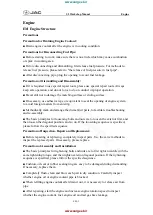
▷
In thick fog, wet conditions or snow.
▷
On sharp bends or narrow roads.
▷
If the bumper is dirty, iced up or covered,
for example by stickers.
▷
After work performed incorrectly on the vehi‐
cle paintwork.
▷
When a projecting load is being transported.
▷
When there are missing, worn, poorly visible,
merging/separating or ambiguous lane mark‐
ings; for example, in areas where there are
roadworks.
▷
If lane markings are covered by snow, ice, dirt
or water.
▷
If lane markings are not white.
▷
If lane markings are obscured by objects.
▷
If the vehicle is too close to the vehicle ahead.
▷
If there is sustained glare due to oncoming
light, for example if the sun is low in the sky.
▷
If the field of view of the camera or the wind‐
screen in front of the rear-view mirror is soiled
or covered.
▷
If the camera has overheated due to exces‐
sively high temperatures and has been tem‐
porarily deactivated.
▷
Up to 10 seconds after starting the engine
using the start/stop button.
▷
During the camera calibration process imme‐
diately after vehicle delivery.
Attaching any objects, for example stickers or
decals, in the area of the radar beam will also im‐
pair radar sensor operation and may even cause
them to fail.
A Check Control message is displayed in the
event of limited functionality.
The system cannot be switched on when the
trailer socket is in use, for example when operat‐
ing with a trailer or bicycle carrier. A Check Con‐
trol message is shown.
Prevention of rear collision
Principle
The system responds to vehicles approaching
from behind.
General
Two radar sensors in the rear bumper monitor
the area behind the vehicle.
If a vehicle is approaching from behind at a rele‐
vant speed, the system responds as follows:
▷
The hazard warning lights are switched on to
warn the traffic behind if there is a risk of a
rear collision.
▷
appears unavoidable, PreCrash functions are
triggered.
Safety notes
WARNING
The system does not relieve you of your per‐
sonal responsibility to assess the visibility con‐
ditions and traffic situation correctly. There is a
risk of accident. Adapt your driving style to the
traffic conditions. Observe the traffic situation
and intervene actively if the situation warrants it.
Seite 215
Safety
CONTROLS
215
Online Edition for Part no. xxx - VI/19
Summary of Contents for 318D
Page 2: ...Online Edition for Part no xxx VI 19...
Page 6: ...6 Online Edition for Part no xxx VI 19...
Page 7: ...NOTES Notes 8 Owner s Handbook media 18 7 Online Edition for Part no xxx VI 19...
Page 20: ...20 Online Edition for Part no xxx VI 19...
Page 37: ...On the move QUICK REFERENCE 37 Online Edition for Part no xxx VI 19...
Page 38: ...38 Online Edition for Part no xxx VI 19...
Page 312: ...312 Online Edition for Part no xxx VI 19...
Page 332: ...332 Online Edition for Part no xxx VI 19...
Page 397: ...General care MOBILITY 397 Online Edition for Part no xxx VI 19...
Page 398: ...398 Online Edition for Part no xxx VI 19...
Page 411: ...Appendix REFERENCE 411 Online Edition for Part no xxx VI 19...
Page 427: ...BL00I xxx en...
Page 428: ......
















































